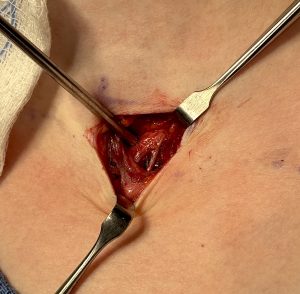One of the unmentioned sequelae of shoulder narrowing surgery is temporary numbness of the upper chest. Since shoulder narrowing is a bilateral procedure such numbness on both sides of the upper chest is common. Although it causes no functional issues and usually slowly resolves a few months after the surgery an anatomic explanation is helpful as it may help avoid even this temporary sensory loss that occurs.
Its explanation can be learned from a far more common approach to clavicle bone surgery, the open treatment of clavicle fractures. In such ORIF of clavicle fractures incisional and chest wall numbness is known to occur in up to 1/3 of such patients. This is due to iatrogenic injury to supraclavicular nerve branches.
The supraclavicular nerve is a superficial sensory nerve originating from the C3 and C4 nerve roots of the superficial cervical plexus. This nerve arborizes just north of the clavicle after passing through the posterior sternocleidomastiod muscle and crosses over the clavicle bone and provides sensation over the clavicle, anteromedial shoulder, and proximal chest. Anatomic studies have shown variability of the number of supraclaviclar nerve branches, usually 2 to 3, that cross over the bone as well as where along the bone they do so. They are not known to get within 2.5cms of the medial sternoclavicular joint or 2 cms within the lateral acromioclavicular joint. (aka known as the safe zones)

While temporary chest numbness is the undesired and usually unavoidable sequelae of this surgery it eventually resolves. This is undoubtably due to another one of its branches providing a conduit for sensory recovery. But in the uncommon case where the nerve branch is seen preserving it, despite some stretch on it, does avoid most of the chest numbness.
Dr. Barry Eppley
World-Renowned Plastic Surgeon


